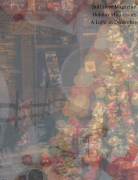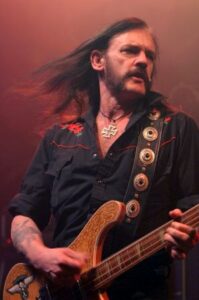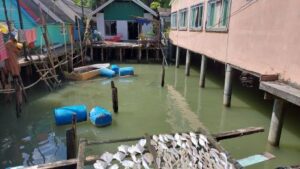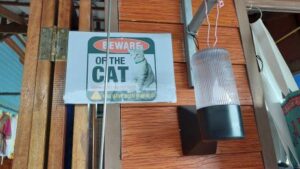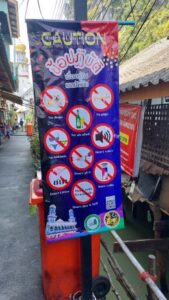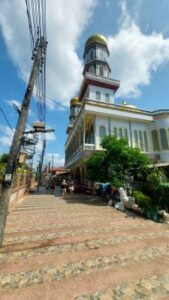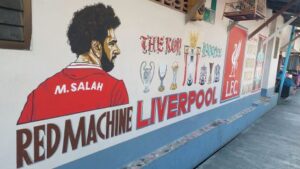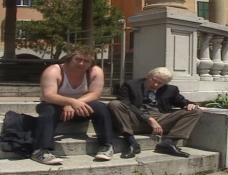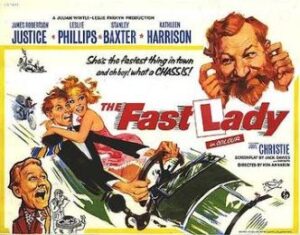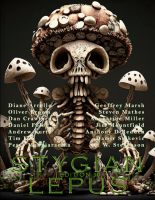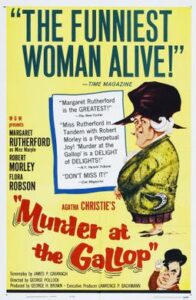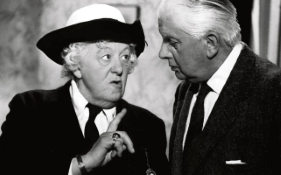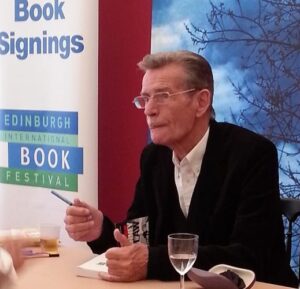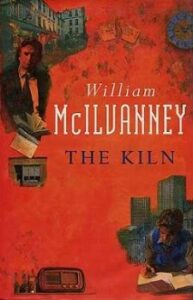
© Schlock! Webzine
All in all, 2025 was a horrible year: one in which an unholy alliance of authoritarians, kleptocrats, fascists, media tycoons, tech bros and oil barons worked hard at stripping freedoms from those of us living in societies that have, until now, retained some freedoms; at transferring another huge chunk of wealth from our dwindling coffers to their swelling coffers; and at burning and poisoning the planet we live on in their quest for profits whilst aggressively pushing the line that any science questioning this policy is a ‘hoax’. But you’ve probably noticed that. You don’t need me to tell you.
On a personal level, and regarding my writing career, 2025 for a time looked like it would be horrible too. The previous year, 2024, had been my most successful one ever, with its twelve months seeing 17 of my short stories published. However, in my writing round-up for 2024, I noted warily that “I will be hard-pressed to equal or better that record in 2025… That’s because of the recent disappearances of certain magazines (like The Sirens Call) and publishers (like Midnight Street Press) who have published my stuff regularly in the past.” Yes, those closures impacted on me this year. But for a period of four of five months in the middle of 2025, I really felt that, submissions-wise, I couldn’t get myself arrested. I sent story after story to publication after publication and, relentlessly, rejection after rejection came back.
For a while, my efforts at fiction seemed about as popular as a Cybertruck in a Tesla showroom in a district of Washington DC heavily populated by ex-government employees.
But… “If at first you don’t succeed, Mr Kidd…” “…Try, try again, Mr Wint.”
In keeping with the philosophy of Mr Kidd and Mr Wint, the two camp assassins in Diamonds are Forever (1971) who indefatigably persevere in in their efforts to dispose of Sean Connery, I tried and tried again. And unexpectedly, I had a breakthrough near the end of the year. Half-a-dozen of my stories got into print in November and December. Also surprising – since I’ve never considered myself a particularly Christmassy person – was the fact that three of these stories appeared in anthologies or magazine issues dedicated to the festive season.
Anyway, here’s a summary of the fiction I’ve had published in 2025. It includes details of where they were published, which pseudonym they were published under and how they can be accessed today.
As Jim Mountfield:
- Jim Mountfield, the penname under which I write horror stories, had his first 2025 success with a story that appeared in Issue 22 of the Stygian Lepus magazine. It was entitled Beach Bodies, was set in Bali, and was about an older man coming into conflict with an extreme manifestation of the foreign backpacker and influencer culture that overruns the island’s tourist spots. Issue 22 of the Stygian Lepus can be purchased here.
- In July, a Mountfield story called Slot Boy was featured in Volume 19, Issue 6 of Schlock! Webzine. At the time I described Slot Boy, which was set in Scotland and not wholly serious in tone, as having a “Scottish backdrop of parochial wee towns, middle-aged neds, cranky auld wifies, mobility scooters, and terrible football.” You can buy that particular issue of Schlock! Webzine here.

© Spiral Tower Press
- My next two Mountfield stories were also set in Scotland. Halloween 2025 saw the release of Issue 5 of Witch House Magazine, whose contents included The Bustle in the Hedgerow. This story drew on a number of inspirations: a historian who once visited my family’s farm while hunting for the remains of a Roman fort; a hedge my father once planted on the farm after receiving an environmental grant; and the supposedly true story of two ancient Celtic stone heads, known as the Hexham Heads, which caused terrifying paranormal activity to assail anyone who came into ownership of them. The Hexham Heads traumatized a generation of kids in the UK in the 1970s when the BBC current-affairs show Nationwide broadcast a report about them. Issue 5 of Witch House can be downloaded here.
- Early in December, a Mountfield story called The Dark Crooked One appeared in a seasonal anthology from Black Hare Press, Eerie Christmas 4. This combined a legend about Scottish bogeyman who supposedly appears during the shortest days of the year, including December 25th, with the real-life tensions that can arise at Christmas – namely, when you stick a not-particularly-happy family together in a room all day, make them eat and drink too much, and pressurise them into acting like they’re having a good time when, in fact, they’re not. Go here to buy a copy of Eerie Christmas 4.
- And later in December, Jim Mountfield was responsible for the first part of a science-fictional horror story, entitled Appopolis Now and set in an imaginary Asian country in the near-future, that turned up in Issue 30 of the Stygian Lepus. Appopolis Now is currently available to read here. Its second and final part should appear in the 31st issue of the Stygian Lepus next month.
As Rab Foster:
- Meanwhile, my fantasy-writing alter-ego Rab Foster had his first 2025 story published in April when one called The Cats and the Crimson was accepted for Issue 159 of the monthly webzine Swords and Sorcery Magazine. The first half of the title reflects the fact that the story contains cats – both domestic cats and some ghoulish, demonic variations on the feline species. The second half of it indicates the presence in its cast of Cranna the Crimson, a fearless and rather incorrigible swordswoman who’s already been a character in two of my earlier published stories. You can read the story in Swords and Sorcery Magazine’s archive, here.
- The next month, a Foster story called The Shrine on the Moor appeared in Volume 19, Issue 4 of Schlock! Webzine. This featured another recurring character of mine, the mercenary Drayak Shathsprey, and was a sequel to a story called Pit of the Orybadak, which had been published in the magazine Savage Realms Monthly at the start of the previous year. Volume 19, Issue 4 can be purchased here.
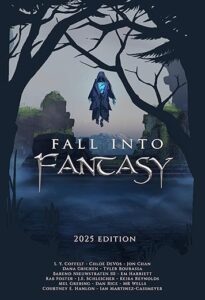
© Cloaked Press, LLC
- September saw the publication of another instalment in the yearly Fall into Fantasy anthology series published by Cloaked Press. Fall into Fantasy 2025’s line-up of stories included a Rab Foster one called From Out the Boundless Deep. Its main character, Kayra, had previously featured in a story called The Trap Master, published in the webzine Aphelion in 2018. As I wrote on this blog: “The premise of both stories is that Kayra inhabits a world where all the creatures of myth and legend – griffins, hydras, harpies, kelpies, minotaurs, etc. – are real and she makes a living by hunting and trapping them.” In From Out the Boundless Deep, Karya gets summoned to a remote beach where something large and mysterious has just been washed up. Fall into Fantasy 2025 is on sale here.
- The year ended with Rab Foster getting another story placed in Swords and Sorcery Magazine, this time one entitled The Palanquin. It’s an attempt to tell a fantasy story set within the confines of a very limited space – the interior of the conveyance of the title. It features yet another recurring character in the Foster universe, the swordswoman and mercenary Keeshan, who appears sometimes as a partner to Drayak Shathsprey and sometimes as a lone agent. Shathsprey has a role in The Palanquin too, but it’s a minor one. Currently, the story can be read here.
As Steve Cashel:
- I usually write non-horror and non-fantasy fiction that’s set in Scotland under the pseudonym Steve Cashel. This year, atypically, he had a story turn up in another anthology of supernatural Christmas tales, White Witch’s Hat and Other Yuletide Ghost Stories from Heavenly Flower Publishing. The reason for this was because the story in question, Southbound Traveller, was set in a Scottish household on Christmas Day in the early 1990s and for most of its length was realistic in tone. Only near the end does something strange happen – and it’s more a ‘paranormal incident’ than a manifestation by a ghost or other supernatural entity. (An inspiration for the story was actually Hans Christian Anderson’s 1845 fairy tale The Little Match Girl.) It seemed more like a Steve Cashel story than a Jim Mountfield one, so Cashel got the credit. To purchase a copy of White Witch’s Hat and Other Yuletide Ghost Stories, please click here.

© Heavenly Flower Publishing
As Paul McAllister
- Finally, I managed to get two short stories published in December 2025 under the penname of Paul McAllister, which I use for non-scary, non-fantastical fiction set in Ireland. This felt like scoring two goals in injury time at the end of a football match. The first of the stories was called That Time and was based on a memory of a brief but harrowing incident that happened to me when I was about eight years old and living in Northern Ireland. That Time was included in Issue 2 of the digital magazine Still Here, whose title and theme was Ghosts of our Pasts. A pdf of Issue 2 can be downloaded here.
- And the team behind Still Here also decided to put out a mini-issue to coincide with Christmas Day, entitled A Light in December. I managed to get a Paul McAllister story selected for that as well. Called The Recovery, it’s another one that takes place in Northern Ireland. It involves a funeral, during the run-up to Christmas, and a case of mistaken identity. Again, you can download a pdf of the mini-issue here.
In the end, despite my pessimistic predictions, I managed to get twelve short stories published during 2025. Prior to the bumper year of 2024, a dozen published stories was my average total each year. So, I didn’t fare so badly after all. From this experience, I would give budding writers two pieces of advice: (1) never give up (which is the advice all writers give aspiring writers); and (2) have lots of Christmas stories ready in your arsenal for the next round of seasonal anthologies. I’ve already started writing a couple for Christmas 2026.
Meanwhile… A Happy New Year to you all.

© Stygian Lepus





